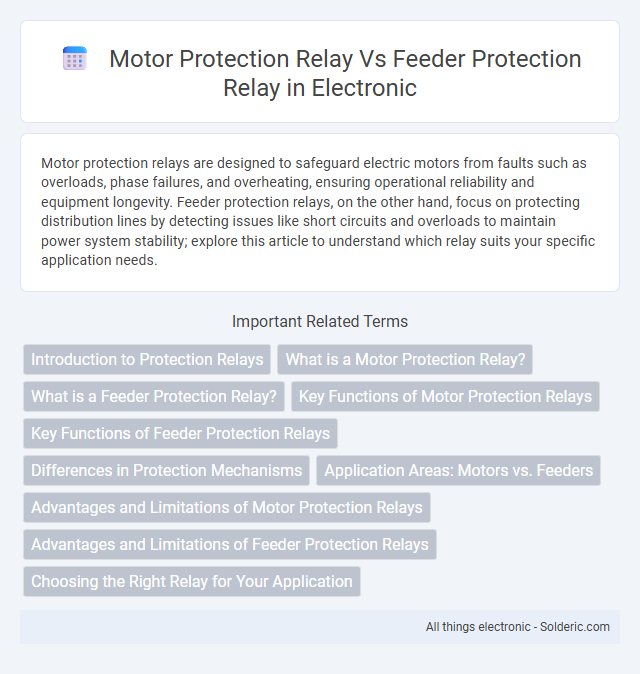Motor protection relays are designed to safeguard electric motors from faults such as overloads, phase failures, and overheating, ensuring operational reliability and equipment longevity. Feeder protection relays, on the other hand, focus on protecting distribution lines by detecting issues like short circuits and overloads to maintain power system stability; explore this article to understand which relay suits your specific application needs.
Comparison Table
| Feature | Motor Protection Relay | Feeder Protection Relay |
|---|---|---|
| Purpose | Protects electric motors from faults like overload, short circuit, phase failure | Protects distribution feeders from faults such as overload, short circuit, earth fault |
| Fault Types | Overload, phase loss, locked rotor, stall, ground fault | Overcurrent, earth fault, phase fault, voltage abnormalities |
| Typical Application | Motors in industrial and commercial installations | Power distribution feeders in substations and networks |
| Protection Method | Monitors motor current, temperature, and voltage conditions | Monitors feeder current, voltage, and fault currents |
| Relay Settings | Current thresholds based on motor rating and thermal characteristics | Current thresholds based on feeder capacity and coordination studies |
| Typical Features | Overload trips, phase failure trip, stall protection, ground fault detection | Overcurrent trip, earth fault trip, directional protection, auto-reclose |
Introduction to Protection Relays
Protection relays serve as critical devices in electrical power systems, designed to detect faults and initiate circuit breakers to prevent damage to equipment. Motor protection relays specifically safeguard electric motors by monitoring parameters like current, voltage, and temperature to prevent issues such as overloads, phase failures, and overheating. Feeder protection relays focus on protecting distribution feeders by detecting faults like short circuits and overloads, ensuring the stability and reliability of power delivery across the network.
What is a Motor Protection Relay?
A motor protection relay is a specialized device designed to safeguard electric motors from faults such as overload, phase failure, ground faults, and short circuits by continuously monitoring current, voltage, and temperature parameters. It ensures reliable motor operation by disconnecting the motor from the power supply during abnormal conditions, thereby preventing damage and reducing downtime. These relays are crucial in industrial applications, improving motor lifespan and operational efficiency.
What is a Feeder Protection Relay?
A Feeder Protection Relay is designed to safeguard electrical distribution feeders from faults such as short circuits, overloads, and ground faults by quickly isolating the faulty section to prevent damage and ensure system stability. Unlike motor protection relays that specifically monitor motor parameters like current, temperature, and voltage, feeder relays focus on maintaining the integrity of the feeder line and downstream equipment by detecting abnormalities in current flow and fault conditions. Your electrical system's reliability depends on correctly selecting and setting these relays to provide fast, precise fault detection and isolation.
Key Functions of Motor Protection Relays
Motor protection relays primarily safeguard electric motors from faults such as overload, phase failure, short circuits, and overheating by monitoring current, voltage, and temperature parameters. These relays ensure motor longevity and operational efficiency by rapidly disconnecting power during abnormal conditions to prevent damage. Unlike feeder protection relays focused on overall circuit protection, motor protection relays deliver tailored responses specific to the motor's operational characteristics and fault tolerance.
Key Functions of Feeder Protection Relays
Feeder protection relays primarily safeguard electrical feeders by detecting faults such as overloads, short circuits, and ground faults to prevent equipment damage and ensure system reliability. These relays rapidly isolate faulty sections, minimizing service interruptions and maintaining power quality across the distribution network. Your electrical system benefits from enhanced safety and operational efficiency through the precise fault detection and tripping capabilities of feeder protection relays.
Differences in Protection Mechanisms
Motor protection relays primarily safeguard electric motors by monitoring parameters like overload, locked rotor, and phase imbalance to prevent mechanical and thermal damage. Feeder protection relays focus on detecting faults such as short circuits, earth faults, and overloads along power distribution feeders to maintain system stability and prevent cascading failures. The distinct protection mechanisms reflect their specialized roles: motor relays emphasize motor-specific conditions, while feeder relays target broader electrical network faults.
Application Areas: Motors vs. Feeders
Motor protection relays are primarily used to safeguard electric motors from faults such as overload, phase failure, and stall conditions, ensuring reliable motor operation in industrial and manufacturing environments. Feeder protection relays are designed to protect distribution feeders by detecting faults like short circuits, overloads, and earth faults to maintain power system stability and minimize outage durations. Both relay types are essential in electrical distribution systems, with motor protection relays focusing on individual motor health and feeder protection relays emphasizing broader supply continuity.
Advantages and Limitations of Motor Protection Relays
Motor protection relays provide precise fault detection and overload protection tailored specifically for electric motors, enhancing motor lifespan and reducing downtime. These relays offer advantages such as thermal, overload, phase failure, and locked rotor protection, ensuring comprehensive motor safeguarding. Limitations include limited application to motor circuits only, less effectiveness in protecting the entire feeder system, and possible inability to detect faults beyond motor terminals.
Advantages and Limitations of Feeder Protection Relays
Feeder protection relays offer precise fault detection and isolation capabilities, ensuring reliable protection of electrical distribution feeders. They enhance system stability by quickly isolating faults, minimizing downtime and damage to connected equipment. Your electrical system benefits from improved operational efficiency, but these relays may have limitations in handling complex fault conditions compared to motor protection relays.
Choosing the Right Relay for Your Application
Selecting the right relay depends on the protection needs of your electrical system; motor protection relays safeguard motors against overload, phase failure, and temperature rise, ensuring operational longevity. Feeder protection relays, on the other hand, focus on protecting distribution feeders from short circuits, overloads, and faults, preserving system stability and continuity. Understanding your system's specific requirements, such as the type of equipment and fault conditions, is essential to choose between motor protection and feeder protection relays for optimal safety and efficiency.
motor protection relay vs feeder protection relay Infographic

 solderic.com
solderic.com